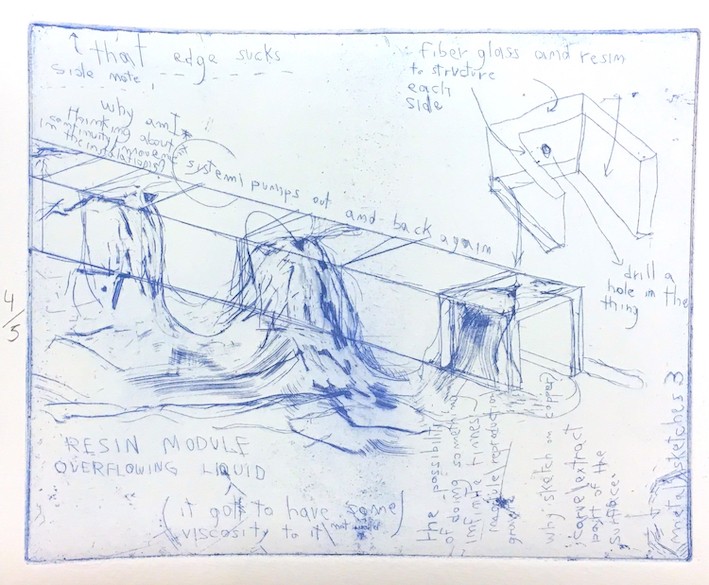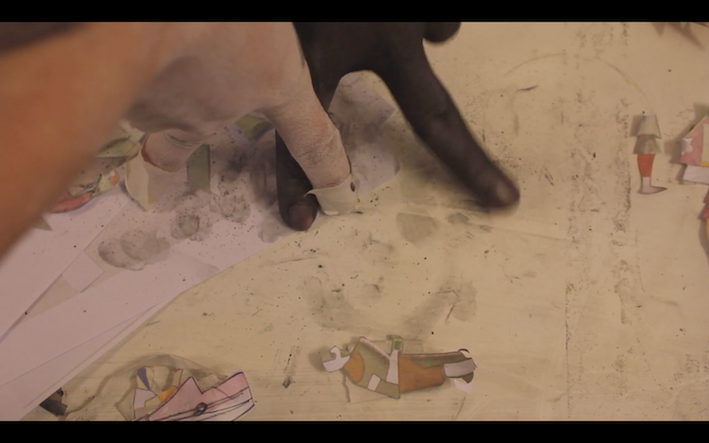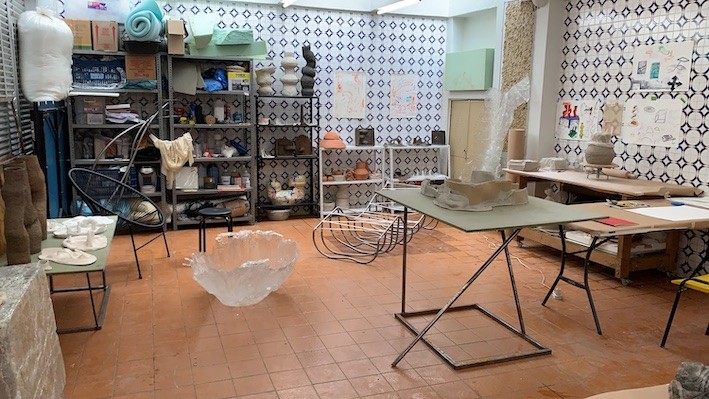Uncovering the Heritage Silhouette: Raphaela Melsohn
I saw that you did a residency in Beijing, China in 2016. What was your experience like? What were you working on?
RM: In Beijing, my work used drawings as a process of communication. This was a way of translating myself in an environment where I was a foreigner. A foreigner in the sense of not sharing my mother tongue with the space, the country. I did several actions trying to find different ways of communicating with people who spoke the same language as me. One example was to buy postcards from tourist places and attempt to write messages that were observation-based drawings. Instead of speaking a language, I tried to communicate through drawings. This made sense to me because when I look at the writing of the land, they look like drawings to me.
Even though this isn’t directly related to my practice, this allowed me to start thinking about translation and communication within myself as an artist. A lot of my work comes from that place and my decision to be in an MFA in a foreign country was also because of my interest in creating as a foreigner. I want to see the reactions to my work in a foreign country where many may not be able to understand my references and context. I’m interested in making that work.
That’s right. Before coming to Columbia, the majority of your exhibitions were in Brazil. In 2018, you started showing in New York too. How do you decide which language to title your pieces?
RM: I first started translating a lot of my titles from Portuguese to English when I got to New York. Most of what I write in English is not always grammatically correct and it's part of the experience of a foreigner. I use the English that lives in my head. Naturally as I lived in New York longer, I started to use English more and that is why my works now usually start out in English. Then I realized that I did not need to translate actually. I think it’s enough if you can access one part of the work. In my opinion, when a work is good, you can’t access 100% of the work. Typically, there are so many different ways to look at any piece, many perspectives you can take, many openings.
Some of your earlier works (Studies for a Shell, Déjeuner sur Kurosawa) are influenced by Japanese artifacts and also some French inspirations. What made you want to highlight foreign cultures, and would you say that you are authorized to?
RM: Being born, educated, and spending most of my career in Brazil I had a particular education. As many, I would learn from books given to me at school, and I specially had learned a lot from bourgeois catalogs. I learned a lot from reading images in catalogs than actually seeing artifacts in real life. A lot of artists I only contact through catalogs. I saw these pieces as my own even though they came from many places in the sense of being my references. I feel like I own them as much as an American artist owns them.
So when I use those types of references in my work, which are sometimes very direct such as impressionist paintings or ukiyo-e, I overlap their work with my own hand. I show how I view them. This is a way for me to explain a part of me and my heritage somehow, of course in a very different perspective.
It’s not so programmed. I usually grab what’s around me at the time such as a postcard hidden in the corner of my studio. One time I was watching a ton of Kurosawa movies and I just overlapped things that eventually made a lot of sense. It’s about the way I organize whatever I can.
An earlier piece of yours, "é nada," eu disse or "it's nothing," I said in English, is a video that features direct references to your Brazilian heritage. What were your reference points here?
RM: This was during a time where I recorded a lot of video. When I’m in a situation when I don’t have a studio and do not have many exchanges with people, I do this to displace myself from the work I am doing in order to look back on the work at a later time when I’m in a better situation. This was a series of videos that followed the 2014 works. I was dealing with things that were in my hands that I could access immediately on my table. My hands started this analog collage, and I was inspecting the affect. This is just a dance with my hands to a Brazilian band called Mutantes. The main reference is a drawing by Malevich which I wanted to give motion to. I picked them up with my hands to see how small they were.
How do you gather materials?
RM: The music [in "é nada, eu disse”] was also just the music I was listening to in my studio at the time. I rarely edit my videos, so this was a very organic piece. Now is a bit different, but back then I enjoyed doing 100 takes instead. It’s important for me to be in the zone and enjoy my work. And I gather material in a natural way that allows me to constantly create wherever I am.
I often work on 5 to 10 different works at the same time. It takes longer to finish but I learn so much from one and take it into my other. I usually just take my writings and drawings, which are small things, and formulate them. I can’t really marry any one language, or medium.
I was fascinated by “I immersed myself in the poetry of others” on your website. This project was in contrast a very physical piece but deals with similar concepts.
RM: A lot of my works have been going in this direction of being interested in touch. This was definitely a turning point in my work. I was doing this work before I moved to New York. This was made in my studio where I was working with a lot of furniture. Those at the body scale.
This project started out originally all black, made out of rubber, with large bulges coming out. It is completely different from the finalized version. When I went to New York and the environment completely changed along with the prices of materials. Another work that helped me elaborate a lot of my unfinished ideas was Any bulge can be a hole, and, an in between, a connection. I called this a book even though there are no words. This was a way for me to see possibilities of narrative in the form of holes and bulges. It made me think about them in relation to bodies. This project mimicked pop-up books and what was most important to me was the ability for visitors to play with them in order to understand that there is not a set role of each piece. No pieces perfectly fit so you have to constantly think of other possibilities.
Then when I returned to Brazil during the holidays and returned to the giant block of foam that I had started. I gave myself a month to finalize the work and change it. It turned into white rubber and I cut a lot off which made holes that could also be used as other possibilities. I understand that it is kind of a couch but you can’t sit on it normally without touching the floor. So you would have to find other solutions to be there. I enjoyed that in order to give people a dispositive where people had to give me back solutions. Most architecture, furniture, and many objects do in the world; they suggest what we should do with our bodies. So if we change how the objects are, we can change how we react to them.
What are your current projects in Brazil?
RM: I’m doing some ceramic pieces right now. I’m also working on a chaise long (header image) where you lay down and look up upon a video that I’m also currently editing. I first sketched the project and brought it into watercolor, then I brought it to life. I used a lot of references of different types of chairs. My current studio is filled with all my projects. I’m working on a few fountains right now also.
Read more from the "Uncovering the Heritage Silhouette" series




